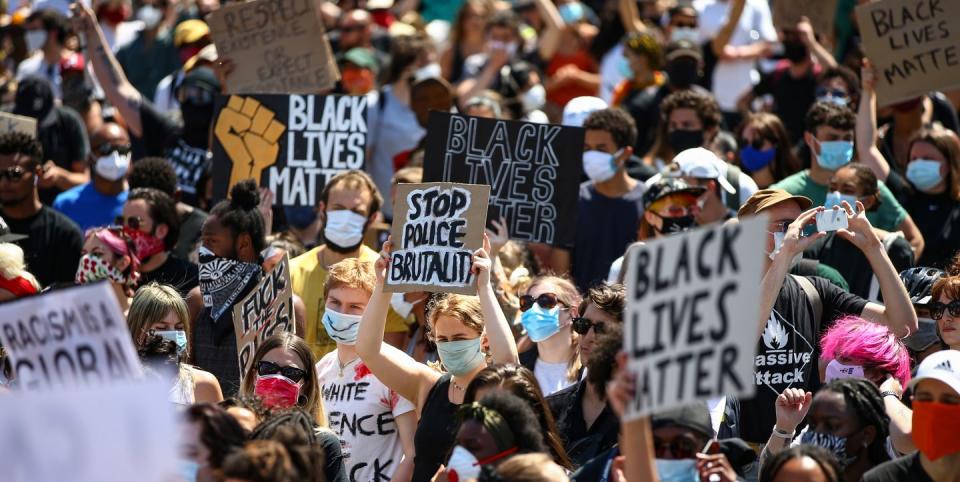How to Protest Safely During the Coronavirus Pandemic

Last Monday, a 46-year-old Minneapolis man named George Floyd was killed by a police officer named Derek Chauvin. Chauvin put his knee on Floyd's neck for close to nine minutes, including the three minutes when Floyd was unresponsive. Chauvin has been charged with third-degree murder.
This happened in the middle of a global pandemic, but cities across the world are holding protests filled with residents who want to speak out against unjust deaths in the black community. People are suiting up in masks, grabbing signs, and taking to the streets to protest violence from police and yet are still coming up against more violence from police. Although many of these protests are peaceful, dangers mount as law enforcement and the National Guard presence increases.
i was at the protests in brooklyn yesterday—they were so peaceful...until the nypd escalated them.
— Jessica Roy (@JessicaKRoy) May 31, 2020
But with all of these protests going on, there is another danger that still exists: COVID-19. Here are some ways you can stay safe and healthy as you speak out for what you believe in in the coming days.
There are plenty of pandemic risks to be aware of right while you're standing in solidarity with other protesters. Dr. John Swartzberg, who focuses on infectious diseases at UC Berkeley, told BuzzFeed News that it's important to wear goggles, glasses, and some other eye protection.
"We don't know how important a face shield is or goggles are, but we think it's sufficiently important that we have healthcare workers wear a face shield," he said. He also added that screaming, as one does at a protest, expels a lot more droplets of the coronavirus disease in the air.
"Screaming is going to expel lots more particles with a lot more force," he said. Tear gas, he added, can attack the respiratory system, much like the coronavirus: coughing, gasping for breath, and feelings of asphyxiation are all normal.
Here are some tips for how to stay safe from both the virus and the harmful weapons you might come across at a protest.
Wear a mask
Just like you would at a non-protest event where you might find a crowd, it's important to wear PPE at these protests. And yes, protests are a lot more crowded than your average grocery store these days, but think about what you might wear to safely buy produce during COVID times and dress accordingly. Here's a Google Doc for protest sanitization. Here are tips from the CDC for how to safely wear a cloth mask.
Maintain social distance
Staying six feet away from someone might not be super easy to do during a protest setting, but it is important to do your best to keep your distance as much as possible.
"It really is going to depend upon how socially distant these individuals are, but I do think we have to be worried about any kind of mass gathering spreading the virus in the era of COVID-19," Dr. Amesh A. Adalja told Rolling Stone. "We know that the virus is going to be with us until there is a vaccine, and any type of social interaction where people are within six feet of each other is going to be an opportunity for the virus to infect others and spread between people."
Protect your eyes and body
This DIY guide from Popular Science for what to do if you're exposed to tear gas suggests a few things.
"People just assume it's safe, [but] it's important to know that these weapons actually do cause injuries," Dr. Rohini Haar, an emergency physician, and a research fellow at the Human Rights Center at the University of California, Berkeley, School of Law, told the publication.
The active component in tear gas is 2-chlorobenzalmalononitrile, and it adheres to any moisture it can find on your face. This means tears, saliva, grease in your hair, and mucus that covers your mouth and airways. This means makeup is a no-go. And tear gas aims to make you feel pain.
This means, Popular Science says, that it's important to cover as much of your skin as possible. Yes, it's starting to warm up out there, but the more you have protecting you the better: "The less skin, and the denser the fabric, the better. Forgo shorts and opt for long-sleeved shirts—that will mean less surface for the gas to adhere to," the guide says. But CS powder—the particulate matter that makes up tear gas—does stick to clothes, so if you get sprayed, try to change as soon as you can.
Covering your eyes with goggles is another important tip that can also help as rubber bullets fly through the air. Even ski goggles, which fit tightly over your eyes, will keep tear gas from getting in. Sunglasses won't do the job nearly as well.
Use caution with your technology
This is where regular protest, non-corona precautions kick in. You need to prepare for anything. This means that you should bring along an ID, note cards with "In Case of Emergency" contacts, and use apps such as Signal or WhatsApp to communicate. If you can, don't bring your phone with you or take a burner phone. Here are some other tech-related suggestions for what to do if you do take along your phone with you.
Think about your COVID risk and the risk of others before you go out
If you feel at all worried about your risk of catching COVID-19 or getting someone else sick, there are plenty of ways to help from your couch right now. Do the responsible thing, but stay in this fight however you can.
You Might Also Like

